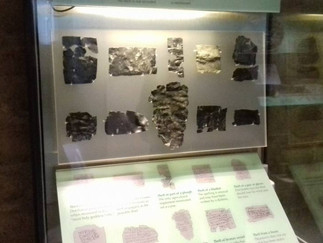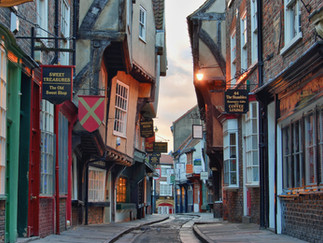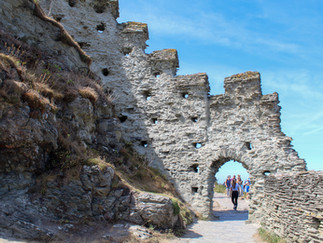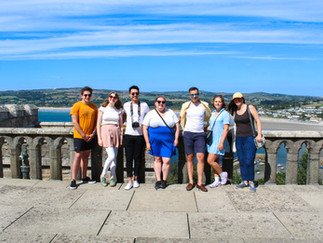Top Places to Visit in the UK if You Love History
- Amelia
- May 16, 2022
- 9 min read
Updated: Jan 25
The UK has a lot to offer, but one of our main attractions is our fascinating past. We've been invaded, we've fought countless wars at home and abroad, and we have a long history of monarchs and aristocrats who built some phenomenal castles and stately homes. Whether you're a history-loving Brit or coming here to discover something new from abroad, there's always somewhere you can go to excite your inner history nerd. So in no particular order, here are some of my favourite historical places in the UK:
1. Cardiff Castle, Cardiff, Wales
Cardiff Castle is pretty much perfect for anyone who loves history, and any period of history at that! The site has been in use since ancient times, and there are remnants from every era on offer: a Roman wall; a Norman keep; Medieval-style décor in a 16th-century house with 18th and 19th-century improvements; Victorian reconstructions of the Roman battlements; and World War II tunnels within the castle walls! Entrance tickets get you access to everything, including the on-site Firing Line museum that tells you about Welsh military history. I'd also fully recommend getting the audio guide, which has information (and optional additional information!) on the entire site.
Website: cardiffcastle.com
Entrance fees: Adults - £15.50, Concessions - £12.50, Children - £10.50
2. Hadrian's Wall, Northumberland & Cumbria, England
Nothing quite exemplifies Britain's rich Roman history like Hadrian's Wall. Stretching nearly 80 miles from the east of England to the west, it was once the northernmost frontier of the Roman empire and is now one of the UK's most important landmarks. There are multiple sites you can visit - forts, milecastles, shrines - some of which are free and some of which have a small entrance fee attached but all are worth visiting. A lot of them are pretty well-preserved, and many of the forts now also have museums on-site to showcase the vast array of archaeological finds that have been discovered there, which have been invaluable to our knowledge of life in the Roman army and in the province of Britannia. Of course, you can go on days out to individual sites or for those who love a good hike, you can even walk it!
Website: hadrianswallcountry.co.uk
Entrance fees: (Dependent on specific sites - see website for more information)
3. The Roman Baths, Bath, England
The Roman Baths are arguably one of the most popular historic attractions in the UK, and its fame is well-deserved. Originally a holy site for the local native community, it was converted when the Romans arrived into a temple for the newly syncretised ('hybrid') goddess Sulis-Minerva: an amalgamation of the Roman goddess of wisdom and the native goddess to whom the site was originally dedicated. The baths and on-site museum make for an amazing day out for the keen historian, especially if you have an interest in Romano-British religion. Some of the most fascinating finds on display are the famous curse tablets, inscribed mostly in Greek on sheets of lead and thrown into the waters by those who wanted the goddess to exact justice after having been robbed or slighted. You can also see what remains of the original temple pediment, and maybe have a go at theorising for yourself whose the mystery face might be...
Website: romanbaths.co.uk
Entrance fees: Adults - £28, Concessions - £27, Children - £21. Cheaper on weekdays/outside of peak season.
4. The Box Museum, Gallery & Archive, Plymouth, England
The Box is one of Plymouth's major highlights. Ok, having been a volunteer there myself in the past, I might be a little biased but if anything, volunteering there has only increased my appreciation for just how fantastic this organisation is. Each and every exhibition is curated with a great deal of both creativity and sensitivity, and there's no shying away from talking about how Britain has played a part in the more difficult areas of history, such as slavery and the first settlement of North America. The Box has hosted internationally-acclaimed touring exhibitions such as Songlines: Tracking the Seven Sisters (from the National Museum of Australia), but still takes the time to celebrate local heritage, from ancient Devon to the first voyage of the Mayflower, and right up to what Plymouth was like in the 20th and early 21st centuries. We also have Mildred, our very own woolly mammoth!
Website: theboxplymouth.com
Entrance fees: Free
5. Hampton Court Palace, London, England
If like me, you're a fan of Britain's early modern period, then Hampton Court is the place to be. Given to Henry VIII by Cardinal Wolsey in 1529, it became a favourite royal residence for British monarchs right into the Georgian period. The palace feels endless - it's a rabbit warren of beautiful rooms, including the magnificent Royal Chapel, Henry VIII's Great Hall, William III and Mary II's apartments, and so much more. You can even eat in Elizabeth I's privy kitchen! The grounds are also absolutely stunning, especially during the late spring/early summer months when everything is in full bloom such as the Great Wisteria, and everything is beautifully landscaped to create a true Baroque oasis, designed by Capability Brown himself. Definitely somewhere that should be up there on your historic UK to-do list!
Website: hrp.org.uk/hampton-court-palace
Entrance fees: Adults - £30, Concessions - £24, Children - £15. Cheaper outside of peak times.
6. Royal Albert Dock, Liverpool, England
If what you're looking for is a historic site with food and some very pretty views, look no further than Liverpool's Royal Albert Dock. Opened in 1846 by Prince Albert, it was built around the 1716 Thomas Steers dock - the world’s first commercial wet dock - and over the last three centuries it played an essential role in Liverpool becoming a centre of global trade until steamships simply became too big to dock there. After it sustained substantial damage in the blitz of 1941, it was essentially abandoned over the course of the following two decades but thanks to conservation and renovation efforts during the 1970s and 80s, it is now one of Liverpool's must-visit destinations. As well as being a hugely significant location in itself, Royal Albert Dock is also home to multiple museums, including the International Slavery Museum, the Maritime Museum, and the Beatles Story.
Website: albertdock.com
Entrance fees: Free
7. York, North Yorkshire, England
As well as being my own favourite city in the UK, York is, without a doubt, also one of the most historic. Founded by the Romans as Eboracum in the late 1st century AD, it has been occupied ever since and with more attractions per square mile than any other UK city, it has a huge amount on offer for the enthusiastic historian. Experience Viking York at Jorvik Viking Centre, walk the ancient city walls, wander down the 13th-century Shambles, visit York Minster - a holy site since the time of the Anglo-Saxons, climb Clifford's Tower, explore the National Railway Museum, and try to spot the House of York's famous white rose around the city! And, if you're in need of some refreshment after all of that, you might be in need of a trip to The York Roast Co. - the home of the world-famous Yorky Pud Wrap, or maybe a traditional afternoon tea at Betty's.
Website: visityork.org
Entrance fees: N/A
8. The Tower of London, London, England
Over its 1,000-year history, the Tower of London has been a fortress, a palace, and a prison which has held people from almost all backgrounds, from monarchs to peasant rebel leaders and believe me when I say that a visit is worth every penny. Absolutely all of it is covered in the admission fee, including a tour from one of the Yeomen of the Guard, seeing the Crown Jewels, and entry to the Royal Armouries: you could easily spend an entire day there from the minute they open until the minute they close, there's that much to see! I do recommend prioritising what you want to do - as much as I loved it, it was also pretty knackering after a few hours, so definitely grab a map and decide what's at the top of your Tower wishlist before you get going.
Website: hrp.org.uk/tower-of-london
Entrance fees: Adults - £39.50, Concessions - £31.40, Children - £19.80. Cheaper outside of peak times/without donation.
9. Wroxeter Roman City, Shropshire, England
Wroxeter, or Viriconium as it was originally called, is a fantastic site for anyone who wants a glimpse into the everyday life of Roman Britain. Complete with remains of a bathhouse, a forum, and a full replica of a Roman townhouse to walk around, it's easy to imagine it 2,000 years ago as a bustling city. The audio guide, on-site museum, and info plaques tell the stories of those who lived there, and of how this settlement became the fourth largest town in the province of Britannia - almost as big as Pompeii. There 14th and 20th Legions were also stationed here, so whether your interests lie in social or military history, you won't be disappointed either way!
Entrance fees: Adults - £8.60, Concessions - £7.70, Children - £5
10. The Elizabethan House, Plymouth, England
Also managed by The Box is Plymouth's Elizabethan House. Originally thought to be the house of a wealthy man, it has recently been discovered that this was not the case and extensive rearrangements took place to make the visitor experience accurate to the new-found information. Ask for the fully immersive audio-visual tour, which takes you through the last 5 centuries room by room, exploring the stories of the people who built it and lived there, providing an amazingly in-depth insight into the everyday experiences of the Barbican's inhabitants. Also, pro-tip: if you want to keep up with the historical theme afterwards then head just up the road for a drink and a bite to eat at the Tudor Rose Tea Rooms or the Mad Merchant Coffee House.
Entrance fees: Adults - £5, Concessions - £2.50, Children - £2.50
11. Tintagel Castle, Cornwall, England
In need of a history fix but also some phenomenal sea views? Look no further than Tintagel. In the ancient world, it was a major centre of Cornish trade, especially for local tin exports and imports of pottery from the Mediterranean but more than that, it was attributed by Geoffrey of Monmouth as the place where the legendary King Arthur was conceived, and it therefore bears huge significance within the mythological cycles of the British Isles. It was even the motivation for Richard, Earl of Cornwall (the brother of Henry III), to construct the castle: he actually exchanged three of his manors just for Tintagel! Even without these fantastical connections, it's not hard to see why - the views really do speak for themselves - and for the modern history or mythology enthusiast, there really is no better place to fully immerse yourself in it.
Entrance fees: Adults - £18.10, Concessions - £16.30, Children - £11.30. Cheaper outside of peak season.
12. Castell Coch, Tongwynlais, Wales
Castell Coch is every Medieval fairytale lover's dream. It looks as if it's come straight from a storybook, and you can't shake the feeling that you're about to run into a knight in shining armour or a beautiful, courageous princess. It belonged to the Butes - the same family that had Cardiff Castle - so the interior decoration is equally as intricate and fantastic with fairytale references, Medieval scenes, and coats of arms everywhere. Although the Butes owned and decorated Castell Coch in the Victorian era, there are still remains of the 13th-century castle on this site, once the fortress of Gilbert de Clare, 'the Red Earl'. Similarly to Cardiff Castle, I'd once again fully recommend getting the audio guide!
Entrance fees: Adults - £9.50, Concessions - £8.80, Children - £6.70
13. St. Michael's Mount, Marazion, England
St. Michael's Mount might be one of the most iconic landmarks in Europe along with its French counterpart, Mont-Saint-Michel. It is thought to have served initially as a monastery for a Benedictine order, but later it fell out of use as a priory. Over the centuries it was given to or occupied by various lords, before finally being sold to Colonel John St Aubyn, whose descendant James St Aubyn, 5th Baron St Levan still holds it today. Naturally, the island is steeped in folklore, which most famously names it as the home of Cormoran, an 18-foot giant: the scourge of the surrounding villages with a particular taste for cattle and children. According to legend, a young farmer's son named Jack managed to trap Cormoran in a pit and kill him, bringing an end to the reign of terror and earning himself the name 'Jack the Giant Killer' - sound familiar?
Website: stmichaelsmount.co.uk
Entrance fees: Adults - £26, Children - £14. Cheaper without full access (exclude either castle or garden entry).
And there you have it - my recommendations of the top places to visit in the UK if you love history. I'll be continuing to extend this post as I visit more historical sites, so definitely keep an eye out for updates. Happy travelling!
Thank you for reading! If you have any questions or if you'd like to guest-write for The Classicist with an Atlas then I'd love to hear from you - you can get in touch via the form on the Contact page or on Instagram @theclassicistwithanatlas.
None of the links in this post are affiliate links or part of paid advertisements. Photos of The Box are from here, here, and here respectively. York images are from here, here, and here respectively. Photos of the Elizabethan House are from here, here, and here respectively. All prices are accurate as of last post update.














































































